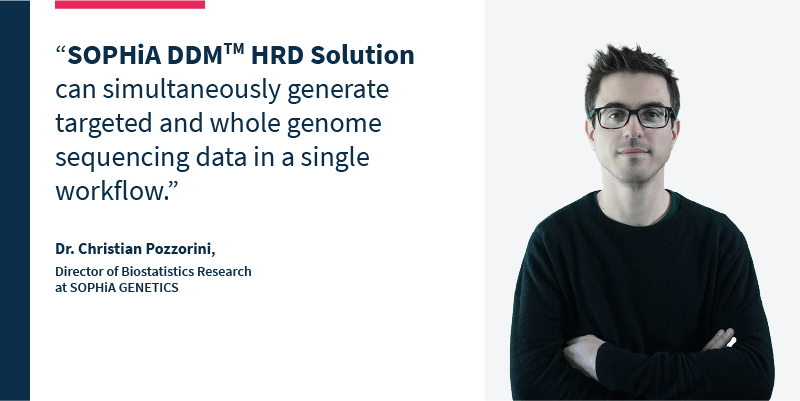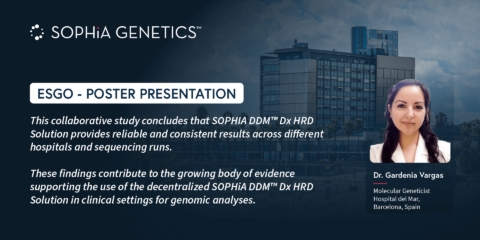Inhibition of poly (ADP-ribose) polymerase (PARP) activity induces synthetic lethality in BRCA-mutated tumors by selectively targeting tumor cells that fail to repair DNA double-strand breaks.1 The term ‘BRCAness’ has been coined to describe tumors that are BRCA wild-type but are still sensitive to treatment with PARP inhibitors (PARPi). Like BRCA-mutated tumors, BRCAness tumors have HRD but have mutations in other genes involved in the homologous recombination repair (HRR) pathway (for example, RAD51, CHEK1, CHEK2, BRIP1, ATM). Detecting aberrations in HRR relevant genes, not only BRCA1 and BRCA2, is important to optimize the use of PARPi.1
In a single assay, the SOPHiA DDM™ HRD Solution combines identification of mutations in 28 HRR genes with a measure of genomic integrity called the Genomic Integrity Index. Powered by deep learning algorithms, the Genomic Integrity Index reveals the extent of genomic scarring as a result of HRR gene mutations across the entire genome.
To gain a better understanding of how SOPHiA GENETICS™ developed the HRD technology, we sat down with Dr. Christian Pozzorini, the Technical Product Manager for the SOPHiA DDM™ HRD Solution and the Director of Biostatistics Research at SOPHiA GENETICS™.
What motivated you to work on the technology for detection of HRD in cancer research?
After studying life sciences and technology with a focus on genetics and molecular biology during my undergraduate years, I went on to do a PhD in computational neuroscience, a field closely related to machine learning. I have worked at SOPHiA GENETICS™ for nearly 6 years and currently lead the Biostatistics Research team. The team has extensive expertise in statistical techniques and machine learning. We investigate different methods by which to extract the maximum value out of next generation sequencing (NGS) data, to best support clinical researchers. Two years ago, we recognized HRD and genomic scarring as a key topic in which machine learning technologies could be beneficial to exploit information hidden in NGS data.
Why is HRD testing important in oncology? What are the clinical benefits of it?
HRD is a hot topic in cancer research and is particularly relevant in clinical practice since novel therapies, such as PARPi, have been developed to target HRD tumors. These drugs were initially prescribed to patients with BRCA-deficient tumors, but it is now clear that some BRCA wild-type patients can benefit from the same treatments. The drugs were indeed conceived to target tumors in which the HRR pathway is deficient, and BRCA mutations are only one subset of mutations leading to HRD. HRD testing is particularly relevant in ovarian cancer patients where HRD is frequent, and where HRD testing has been associated with clinical response to PARPi. Additionally, research has shown that other cancer types may have HRD and so HRD testing may also become standard practice when determining treatment options for these cancers.
HRD testing is particularly relevant in ovarian cancer patients where HRD is frequent, and where HRD testing has been associated with clinical response to PARPi.
Can you explain why detecting HRD may be more complicated than other genomic mutations?
Detecting HRD is made complicated by the fact that multiple genomic mutations may lead to HRD. If a mutation in a known HRR gene is identified, it is difficult to predict its impact on HRD status. For example, does a particular mutation in PTEN impair the HRR pathway?
To overcome this challenge the scientific community proposed a different, yet complementary, approach. Instead of detecting HRD by looking for genomic aberrations known to cause HRD, rather look for genomic aberrations (or genomic scars) that occur as a result of HRD. The challenge of genomic scarring is that it does not happen in specific locations of the human genome. Scars can potentially happen anywhere at the whole genome level, and so genomic scarring interpretation requires NGS data that covers the entire genome.
The most promising genomic scarring approaches rely on high coverage whole genome sequencing (WGS) data and often require sequencing both the tumor sample and a normal tissue-matched control. While these approaches are effective, they are not suitable for routine testing in the clinical setting. The cost of high coverage WGS is still prohibitive and often sequencing paired tumor and control tissues is not feasible.
How did you develop the SOPHiA DDM™ HRD Solution and what are the major features used in this application?
We hypothesized that WGS sequencing performed at low coverage (<1x) could contain sufficient information to detect HRD in samples. To test this hypothesis, we worked on publicly available datasets. These datasets contained high coverage matched tumor-normal WGS, for which the HRD status was established via genomic scars. We conceived a machine learning approach aimed at predicting HRD status by only looking at 1% of the original data in the tumor-only samples, still sequenced genome-wide but at a coverage of 1x or less. Surprisingly, we found that 1% of the data was sufficient to achieve excellent performance in predicting the HRD status that was previously established using 100% of the data.
In collaboration with the SOPHiA GENETICS™ genomic research laboratory, we explored the possibility of extending our library preparation and sequencing pipeline to generate a single workflow that includes: 1) the generation of low coverage WGS data for the detection of genomic scars, and 2) high coverage data for the targeted detection of mutations in HRR genes.
SOPHiA GENETICS’™ standard solutions rely on a targeted sequencing approach whereby an NGS-based WGS library is prepared, enriched, and sequenced to obtain high coverage NGS data in specific genomic regions of interest where variant calling will be performed. One might say that the technology already existed. The only modification was to load the sequencer with both the enriched library and a small amount of the WGS library (before enrichment). Thus, the SOPHiA DDM™ HRD Solution can simultaneously, and economically, generate WGS and targeted sequencing data to detect HRD via a genomic scarring approach (machine learning on WGS data), as well as via a traditional approach (variant calling on targeted data).
The SOPHiA DDM™ HRD Solution can simultaneously, and economically, generate WGS and targeted sequencing data to detect HRD.
What is the Genomic Integrity Index and why is it important in the SOPHiA DDM™ HRD Solution?
Variant calling in HRR genes cannot entirely solve the HRD challenge. The Genomic Integrity Index is computed using our deep learning (a type of machine learning) approach and is a measure of a tumor that while being BRCA wild-type, is HRD positive. Our solution thus allows for the identification of additional HRD positive cancers that can benefit from PARPi.
Can you describe the deep learning method used by the SOPHiA DDM™ HRD Solution to measure genomic integrity?
Deep learning is particularly efficient in solving image classification tasks. A classical textbook example is, given an image, tell me if the image is of a cat or a dog. Convolutional neural networks solve this problem by learning from data which, in this example, is a dataset of images showing cats or dogs. The features present in the images that are best suited to distinguish dogs from cats are selected to train the data. After optimizing the parameters of the neural network, the convolutional neural network can take an image, that was not seen before, and determine whether it is of a cat or a dog.
Our technology works in the same way. The only difference is that the image used as input shows the coverage profile obtained from low coverage WGS data. The task of the convolutional neural network is to establish if the image comes from an HRD-positive or HRD-negative tumor sample.
What data did you use to validate your results?
After training and testing our deep learning algorithm on public data, we started working on clinical FFPE samples from ovarian cancer patients. This work was done in collaboration with some prestigious labs, including Diagnosticos da America SA (DASA) in Brazil. These samples were simultaneously tested with our HRD solution and gold standard methods used for HRD testing. The excellent concordance observed in these studies confirmed the validity of our solution.
In comparison to current approaches available for HRD testing in ovarian cancer, what makes the SOPHiA DDM™ HRD Solution distinctive?
Using a single workflow, our solution allows for the simultaneous generation of targeted sequencing and WGS data. Our deep learning algorithm allows us to make accurate predictions on the HRD status of a tumor sample, without requiring a matched normal sample, making the approach more feasible. Given the power of our deep learning algorithm, only a limited amount of WGS data is required. This allows for multiplexing up to 24 samples in a single Illumina NextSeq® 550, making the solution economically viable for routine testing.
Our deep learning algorithm allows us to make accurate predictions on the HRD status of a tumor sample.
Finally, what are the most important challenges that clinical research can overcome if they rely on the SOPHiA DDM™ HRD Solution?
The ESMO guidelines recommend the incorporation of HRD testing in addition to BRCA testing for women with newly diagnosed advanced ovarian cancer.2 Approved solutions for HRD tests fail to reliably identify patients who will not respond to PARPi. This is compounded by the fact that current solutions for HRD detection are expensive and sometimes infeasible (e.g. require paired tumor-normal samples and use of send-out services). Clinical researchers are thus looking for a cost-effective and reliable test to determine HRD status in ovarian cancers and identify those that could benefit from PARPi in the first-line or maintenance therapies. That is exactly what the SOPHiA DDM™ HRD Solution provides – it allows clinical researchers to independently conduct an accurate and comprehensive 2-in-1 HRD test in-house, in a cost-effective and time-saving manner.
References
- Faraoni I, Graziani G. Cancers (Basel) 2018;10(12):487.
- Colombo N, Lederman JA on behalf of the ESMO Guidelines Committee. Ann Oncol 2021;32(10):1300–03.












